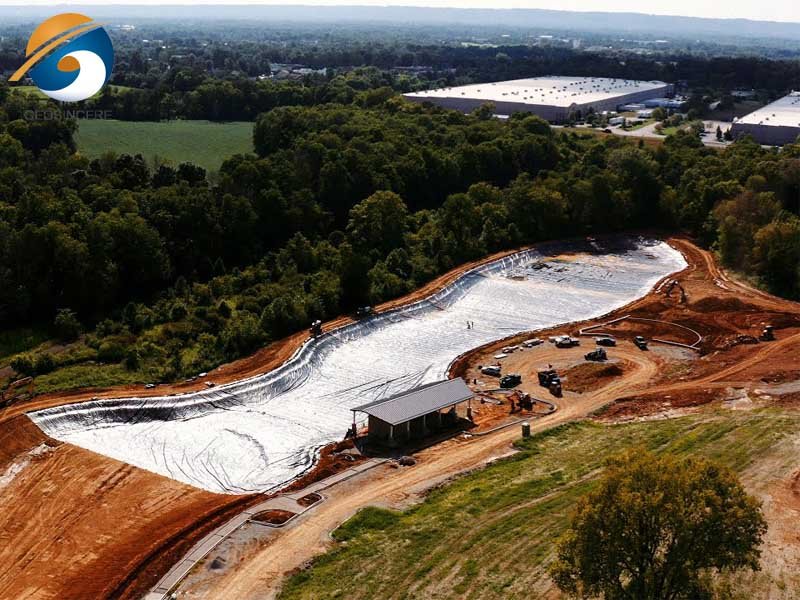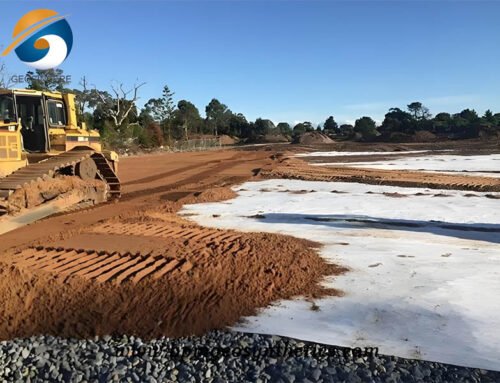High-Density Polyethylene (HDPE) pond liners have become a preferred solution for water containment in a variety of industries, including aquaculture, wastewater management, and environmental engineering. As environmental regulations tighten and infrastructure demands become more stringent, understanding the specific advantages of this engineered geomembrane material is crucial. HDPE liners High Density Polyethylene Pond Liners are increasingly selected over alternatives such as PVC, EPDM, or clay due to their robust performance characteristics. This article explores the numerous benefits of using GEOSINCERE HDPE pond liners, highlighting their technical advantages, operational efficiency, environmental impact, and cost-effectiveness.
1. Unmatched Chemical Resistance
One of the primary reasons HDPE stands out as the ideal material for pond liners is its remarkable resistance to a wide range of chemicals. The semi-crystalline structure of HDPE imparts exceptional chemical inertness, enabling the material to withstand exposure to:
- Extreme pH ranges (from 0 to 14)
- Hydrocarbons and petroleum-based products
- Strong acids and alkalis
- Saline solutions
- Various industrial effluents
Independent laboratory testing, including ASTM D5322 and ASTM D5496, demonstrates that HDPE retains over 95% of its tensile strength after 30 days of immersion in 50% sulfuric acid solutions. This chemical resilience starkly contrasts with the performance of PVC liners, which begin to degrade within 72 hours under similar conditions. As a result, HDPE is especially well-suited for applications such as:
- Mine Leachate Ponds: Where acidic and alkaline chemicals are commonly present.
- Agricultural Runoff Containment: Protecting against contaminants such as fertilizers and pesticides.
- Petrochemical Storage Basins: Ensuring resistance to oils and other hazardous chemicals.
HDPE’s ability to resist chemical damage significantly extends the lifespan of pond linings, reducing the need for costly replacements.
2. Superior UV and Weather Resistance
HDPE offers outstanding resistance to ultraviolet (UV) radiation and extreme weather conditions, making it ideal for outdoor installations. Unlike flexible polyolefins, which require added UV stabilizers, HDPE’s molecular composition provides natural protection against UV degradation. This includes:
- UV Resistance: Over 20 years of protection without the need for plasticizer migration or additional coatings.
- Temperature Range: HDPE can withstand operational temperatures ranging from -60°C to +80°C, making it versatile for both cold and hot climates.
- Ozone Resistance: The material remains unaffected by ozone, a critical feature for prolonged outdoor exposure.
Accelerated weathering tests (ASTM G154) reveal that HDPE retains approximately 89% of its elongation properties after 10,000 hours of UV exposure—significantly outperforming EPDM membranes, which degrade at a much faster rate. Additionally, the material’s thermal stability ensures that it does not become brittle in Arctic climates or soften under intense heat in desert regions.


3. High Density Polyethylene Pond Liners – Enhanced Puncture and Tear Resistance
HDPE liners are highly resistant to punctures and tears, which is critical for maintaining the integrity of ponds over extended periods. Typical thicknesses of HDPE liners range from 1.0mm to 3.0mm, providing exceptional resistance against physical damage. Notable mechanical properties include:
- Puncture Resistance: 280-400N (ASTM D4833)
- Tear Strength: 60-90 kN/m (ASTM D1004)
- Yield Tensile Strength: 25-45 MPa
These characteristics enable HDPE liners to be installed directly over compacted subgrades with less than 3% elongation under hydrostatic loads. Field studies conducted in aquaculture farms indicate that HDPE liners exhibit leakage rates of just 0.02%, compared to 0.15% for reinforced PVC alternatives. These robust mechanical properties make HDPE particularly suited for installations in high-stress environments, ensuring a long-lasting and reliable performance.
4. High Density Polyethylene Pond Liners – Long-Term Cost Efficiency
While the initial cost of HDPE may be higher than materials like clay or low-density polyethylene (LLDPE), its long-term cost efficiency makes it a more economical choice over the lifespan of the project. The following table illustrates the cost comparisons:
| Cost Factor | HDPE | PVC |
| Installation Cost | $1.50-$2.50/sf | $1.20-$1.80/sf |
| Expected Lifespan | 20+ years | 10-15 years |
| Annual Maintenance | 0.5% | 2-3% |
Lifecycle cost analysis (LCCA) models show that HDPE can provide up to 60% in savings over 30 years when compared to PVC. The superior durability of HDPE, combined with its fusion-welded seams, eliminates leak paths common in other types of liners that use glued or taped joints. This reduction in maintenance and repairs can lower remedial costs by as much as 82%, as noted by the International Geosynthetics Society in 2022.
5. High Density Polyethylene Pond Liners – Environmental Compliance and Safety
HDPE is not only durable but also meets rigorous environmental standards, making it a safe and eco-friendly choice for water containment projects. Some of the key certifications and environmental advantages include:
- NSF/ANSI 61: Ensures the material is safe for potable water applications.
- EPA 9090: Certifies the material for waste containment applications.
- EU Regulation 10/2011: Verifies compliance for food-contact materials.
Additionally, HDPE emits less than 0.5% in volatile organic compounds (VOCs), which is in line with California’s CARB ATCM 93120 regulations. The material also does not contain harmful phthalates or bisphenol A (BPA), making it ideal for sensitive aquaculture and agricultural applications.
6. High Density Polyethylene Pond Liners – Installation Versatility and Ease
The installation of HDPE liners is simplified by advanced welding technologies that ensure 100% seam integrity. HDPE liners can be customized to fit complex geometries and even be installed underwater using specialized techniques. Some key features of HDPE installation include:
- Seam Integrity Testing: 100% of seams can be tested for quality assurance via spark or air lance techniques.
- Adaptability: HDPE can be tailored to conform to irregular shapes and depths.
- Underwater Installations: Specialized installation methods allow HDPE to be used in submerged or tidal environments.
An exemplary case study is the Dubai Water Canal Project, which utilized 850,000 square meters of 2.5mm HDPE liner installed across tidal zones. The project achieved a defect-free installation, showcasing the material’s performance and ease of installation.
7. High Density Polyethylene Pond Liners – Recyclability and Sustainability
HDPE is one of the most environmentally sustainable liner materials available, offering high recyclability. Post-consumer HDPE liners can be:
- Reprocessed into new geomembranesthrough closed-loop recycling.
- Repurposed for composite drainage materials, offering additional utility.
- Converted into energythrough waste-to-fuel conversion technologies.
With a recycling rate of 97% (Plastics Europe, 2023), HDPE significantly reduces its environmental impact compared to other materials. Moreover, the carbon footprint of HDPE production is 50% lower than that of virgin production, supporting sustainability initiatives and aligning with circular economy goals.


8. Improved Water Retention
HDPE liners help to optimize water retention in ponds, ensuring a stable water level and preventing seepage. Unlike some materials that may allow water to seep through over time, HDPE creates a tight seal that ensures maximum water containment. This feature is especially crucial for:
- Aquaculture: Where maintaining consistent water levels is vital for the health of aquatic species.
- Agricultural Ponds: In applications that require water retention for irrigation or livestock.
Additionally, HDPE is resistant to root penetration, preventing the growth of weeds or plants through the liner, which could otherwise lead to water loss or damage.
9. Implementation Best Practices
To ensure optimal performance of HDPE pond liners, it is essential to follow best practices during installation. These include:
- Conducting Subgrade CBR (California Bearing Ratio) Testing: A recommended value of >8% ensures adequate support for the liner.
- Using 150mm Overlaps for Field Seams: This ensures secure bonding and leak prevention.
- Performing 10% Destructive Seam Testing: Verifying the quality of the welds and seams before full-scale installation.
- Installing Protective Geotextiles: Placing protective layers over sharp substrates to prevent puncture damage.
10. Conclusion
High-Density Polyethylene pond liners offer a technically superior solution for water containment projects, combining exceptional durability, chemical resistance, UV stability, and cost-effectiveness. From industrial applications like mine leachate containment to aquaculture and landscape water features, HDPE’s versatility and long-term performance make it a preferred choice for sustainable and reliable pond linings. As infrastructure needs increase and environmental considerations become more stringent, HDPE liners provide a durable, cost-efficient, and eco-friendly solution that meets the demands of modern water management. By investing in HDPE, project owners can ensure both regulatory compliance and operational longevity, making it a smart choice for water containment.





